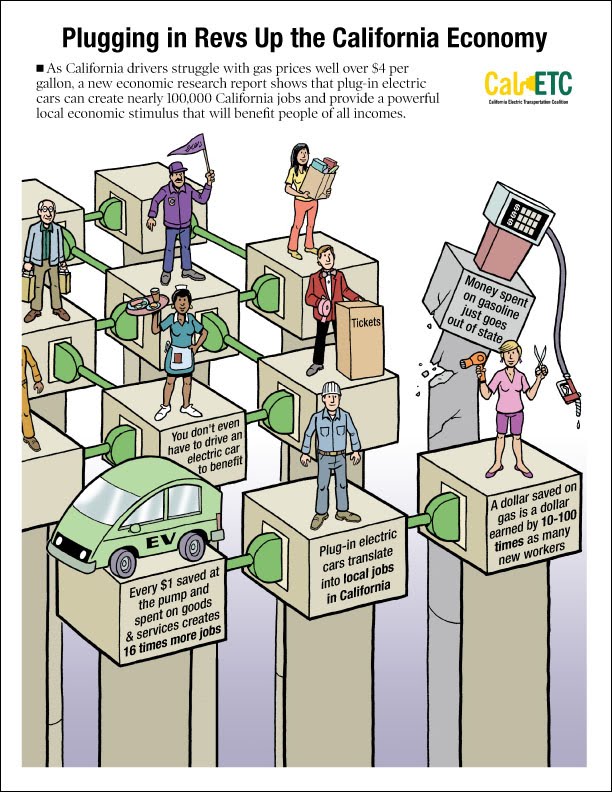Research released Sunday conducted by UC Berkeley economists and the California Electric Transportation Coalition shows that fueling California’s cars and trucks with electricity instead of oil would help grow the state’s economy, creating tens of thousands of new jobs. Simply put, a dollar not spent at the pump is re-directed towards the rest of the economy, creating 16 times more jobs than a dollar spent on gasoline. Saving money at the pump is good for consumers, good for economic growth, and good for California. Good news on “National Plug in Day” for a state that already leads the nation in vehicle electrification.
Governor Jerry Brown recently issued an executive order setting a goal of reducing carbon pollution in the transportation sector to levels necessary to avoid the worst impacts of global warming. If California adopts electric vehicles at a rate sufficient to meet that goal, the cumulative fuel savings would create about 100,000 additional jobs by 2030. It’s not just those who buy electric cars who stand to gain. Those jobs are spread across California’s diverse economy, largely in sectors that cannot be out-sourced. In fact, the economic growth from increased spending on goods and services other than fossil fuels disproportionately benefits lower and middle income households, those most in need of the additional income. Thankfully, California is on track to reap these rewards.
Californians bought nearly 60% of first widely available plug-in vehicles sold in the United States last year, and is home to many of the companies and innovators designing and building electric vehicles and related technologies. It is no accident. California has a singular combination of policies that encourage invention, a legacy of fighting for cleaner air, and a desire to live in the future.
In January, the California Air Resources Board adopted standards that will clean the air, reduce our dependence on oil, and result in one in six vehicles sold in the state being capable of driving emissions free by 2025. Only the month before, the Board adopted amendments the state’s Low Carbon Fuel Standard that improve the economics of vehicle electrification without the use of any public dollars.
Because California’s electricity is some of the cleanest in the nation, electric cars charged in California are already extremely clean. Driving on electricity in the state emits only a quarter the amount of carbon pollution as does the typical new vehicle. Those benefits will only increase overtime as California is on track to produce a third of its electricity from renewable resources by the end of this decade.
The California Public Utilities Commission has demonstrated that utility policies will also play a central role in creating a national market for clean vehicles. In response to a bill sponsored by state Senator Kehoe, the Commission unanimously adopted two substantive policy decisions to “overcome any barriers to the widespread deployment and use of plug-in hybrid and electric vehicles.” Last month, the Commission adopted Pacific Gas & Electric’s new electric vehicle rates that encourage charging during off-peak hours when there’s plenty of spare capacity in the electrical grid at a price that’s roughly equivalent to buck-a-gallon gasoline.
The Commission is implementing many of the recommendations of the California Plug-in Electric Vehicle Collaborative, an organization whose members include automakers, vehicle charging equipment manufacturers, electric utilities, environmental organizations, researchers, and key state and local government officials. In short, many of the folks necessary to ensure California remains on the forefront of clean vehicle deployment.
California has also invested in the research, development, and deployment necessary to maintain the state’s leadership. In 2010, California attracted 80 percent of U.S. venturecapital invesment in EV technology, and the majority of the world’s investments in the field. The state also leads the nation in plug-in vehicle patents, and were California its own country, would only trail Japan and South Korea for number of EV patents. It is no coincidence California is home to countless companies (including 350Green, AeroVironment, Balqon, Boosted Boards, Better Place, ChargePoint, Clean Fuel Connection, ClipperCreek, Coda, Ecotality, Enova Systems, Fisker, Green Charge Networks, Mission Motors, ScootNetworks, Simbol Materials, and Tesla) that are making electric vehicles, batteries, components, charging systems, and related technologies.
California’s leadership is not just the result of the activities described above; real credit goes to Californians, who are purchasing plug-in vehicles at a rate unmatched elsewhere. The progressive policies of the largest electric vehicle market in the country are a reflection of Californians dedication to the future. Though regardless of where you live, once you get behind the wheel of an electric car and enjoy its smooth and rapid acceleration and its quiet cabin, you’ll have a hard time going back to a machine that relies on thousands of small explosions of fossil fuel every minute. Likewise, once you have a chance to lock in the equivalent of buck-a-gallon gas for life, you’ll smile every time you drive right past the pump to enjoy the convenience of re-fueling at home, on a cleaner, domestic fuel. And you can take pride in the knowledge that the money you save on gas will help grow your local economy, instead of padding the pockets of Big Oil.

